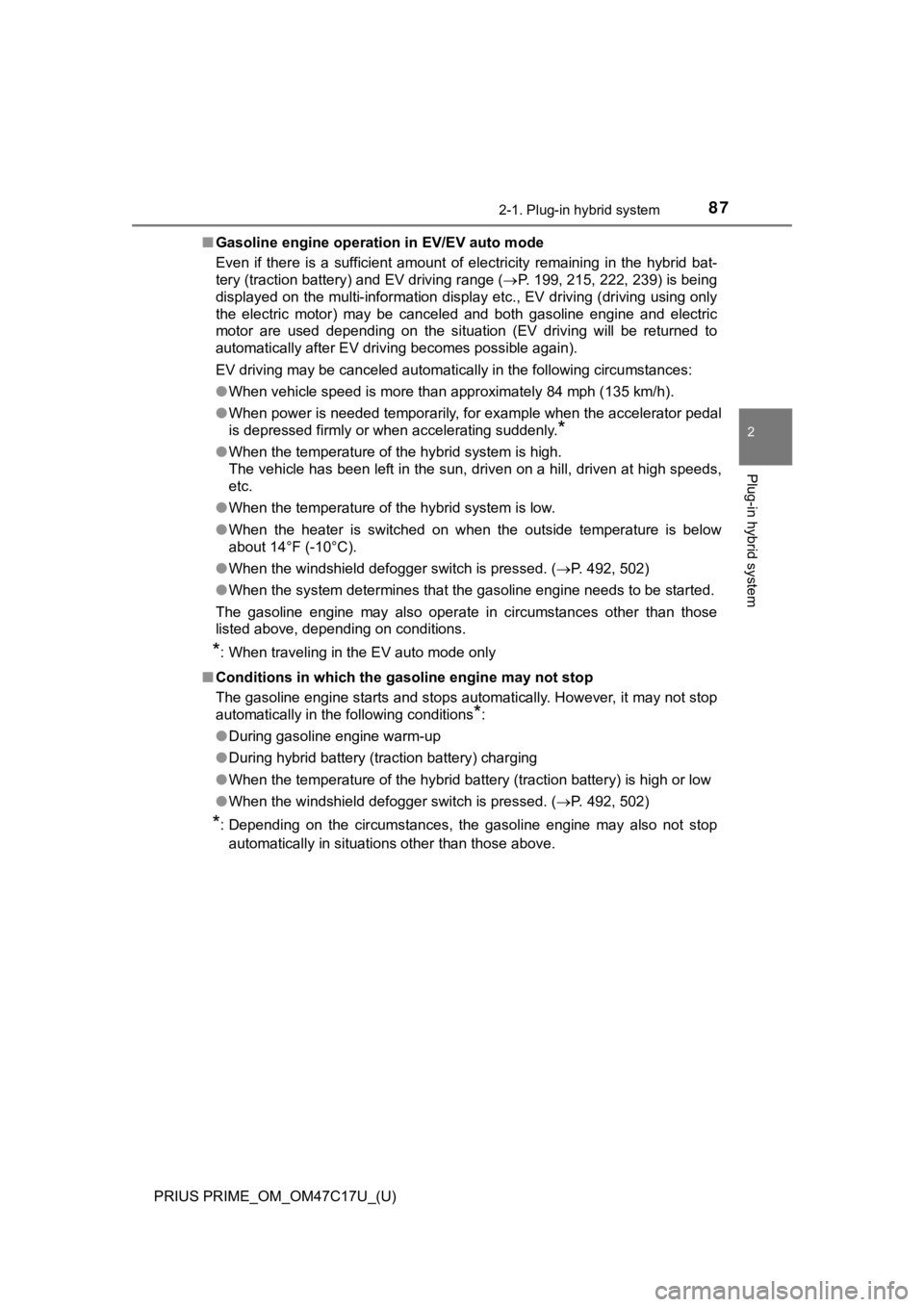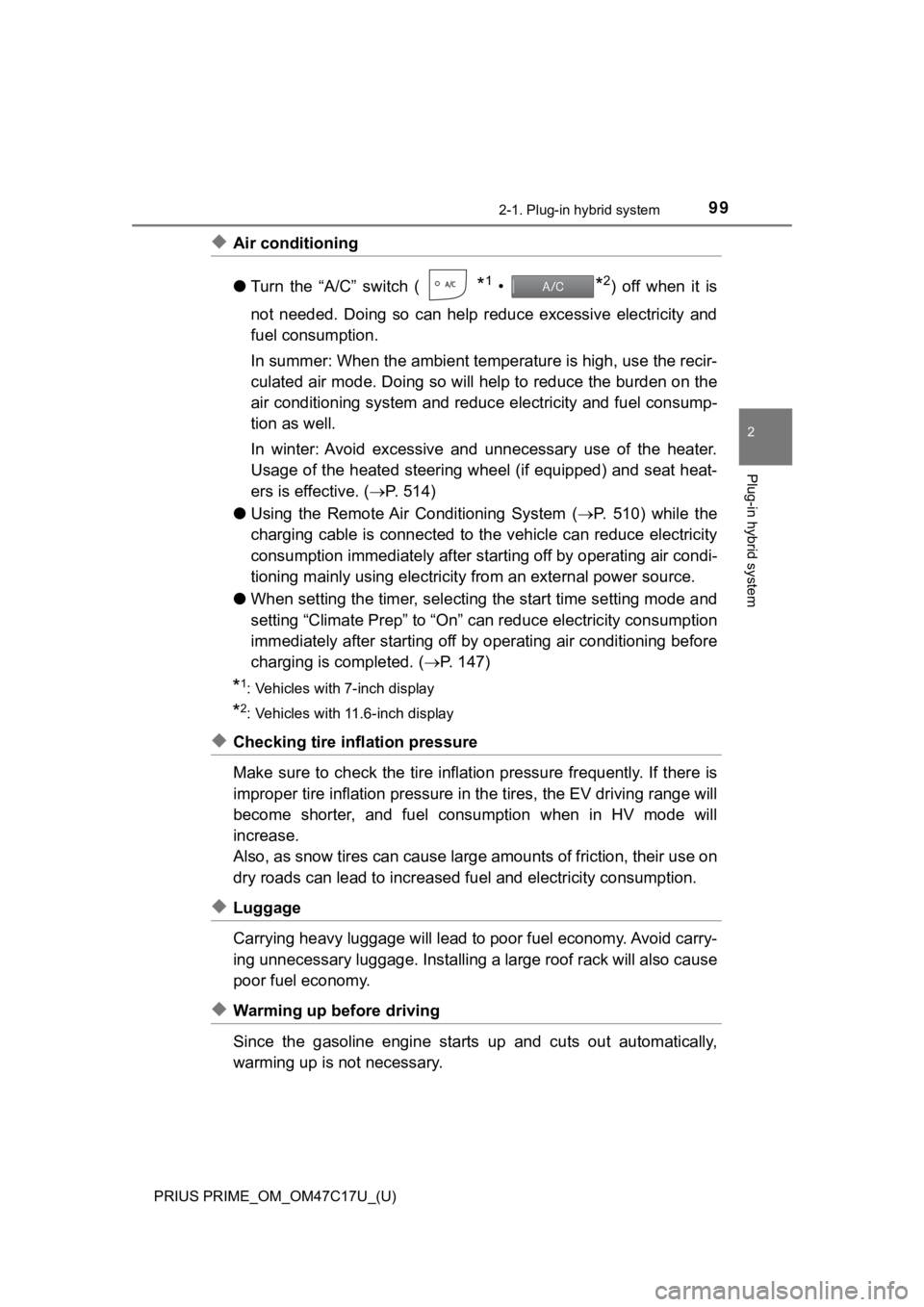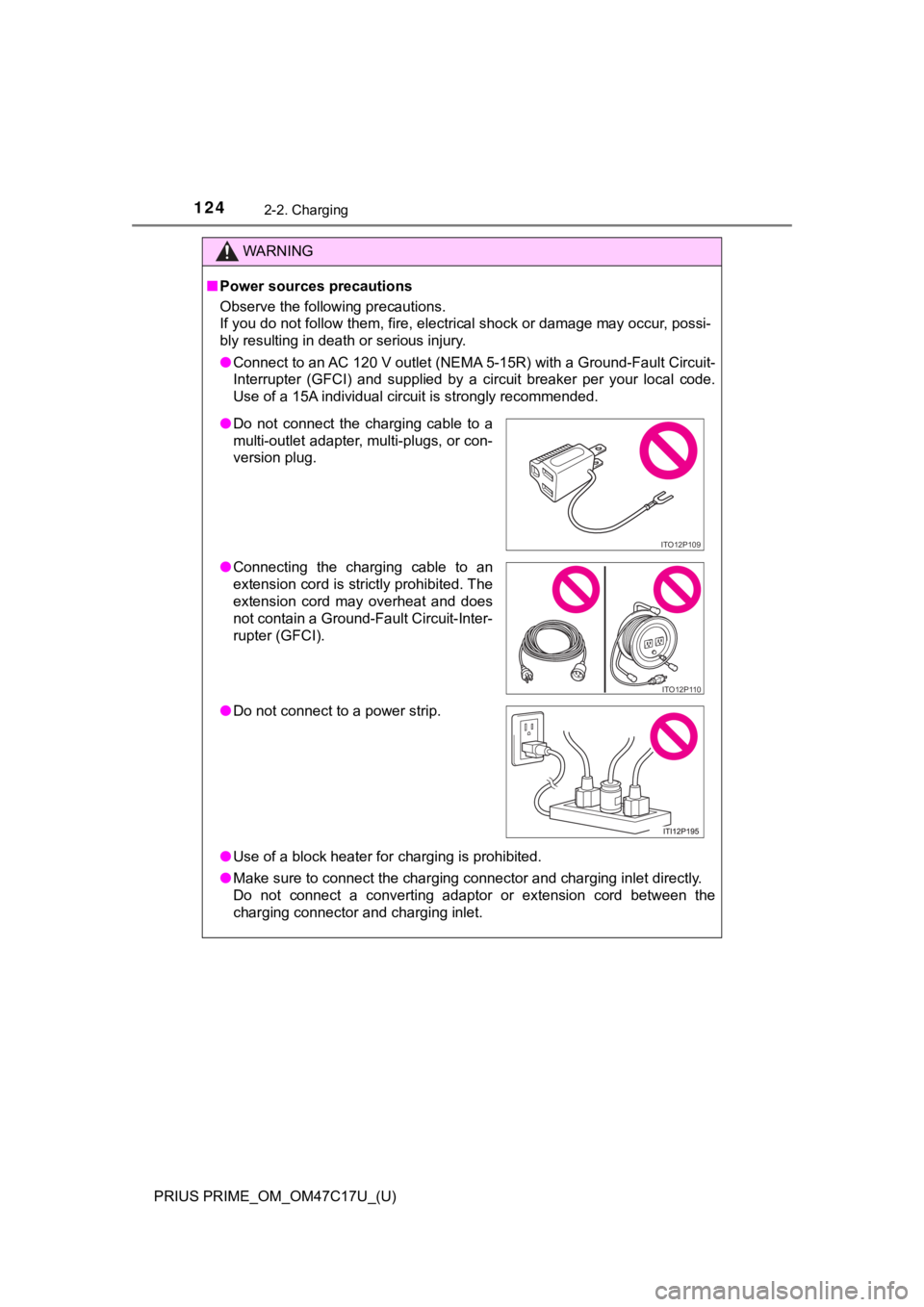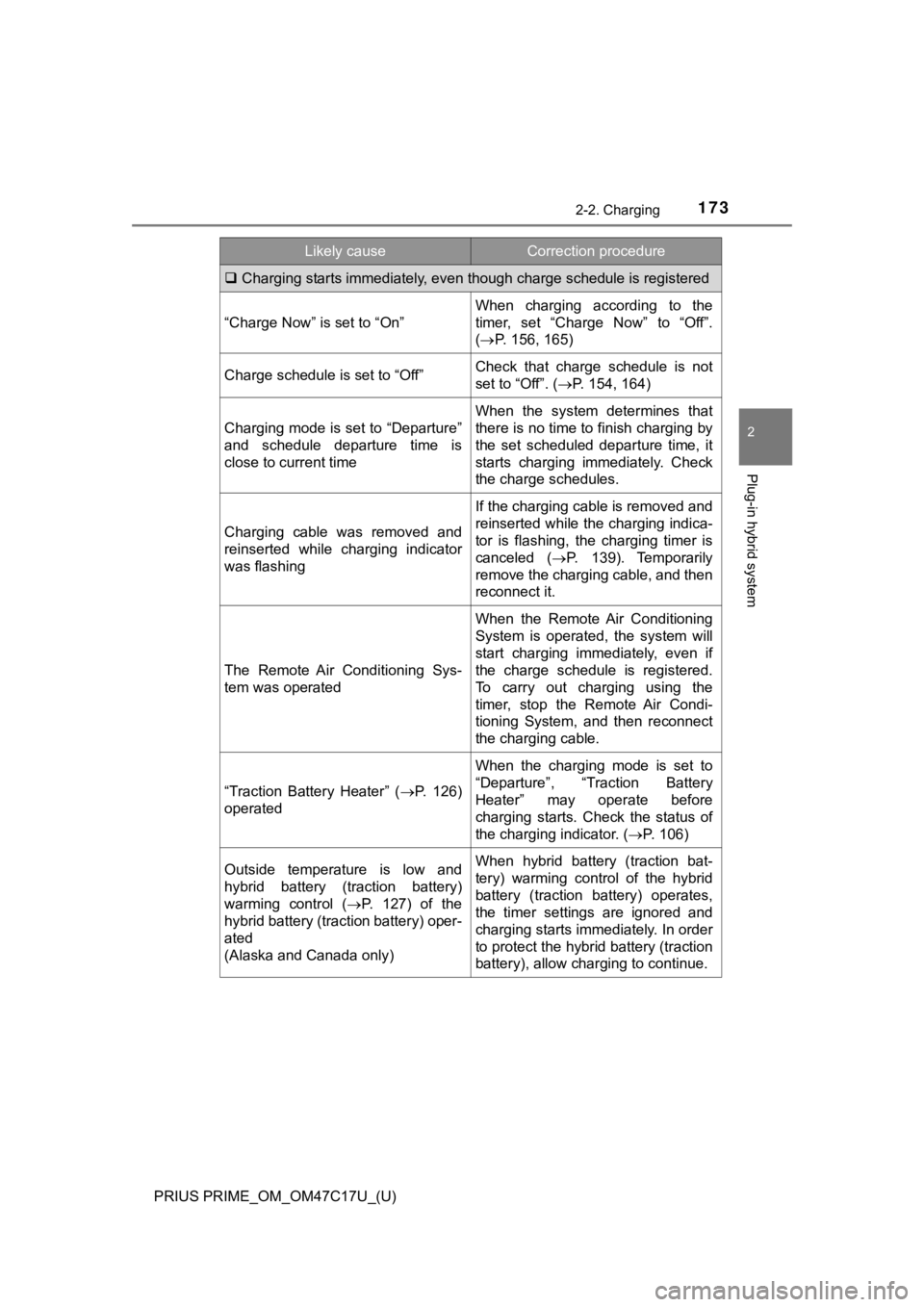heater TOYOTA PRIUS PRIME 2018 Owners Manual (in English)
[x] Cancel search | Manufacturer: TOYOTA, Model Year: 2018, Model line: PRIUS PRIME, Model: TOYOTA PRIUS PRIME 2018Pages: 788, PDF Size: 14.67 MB
Page 4 of 788

TABLE OF CONTENTS4
PRIUS PRIME_OM_OM47C17U_(U)5-5. Using the driving support
systems
Toyota Safety Sense P ..... 361
PCS (Pre-Collision System) ........................... 369
LDA (Lane Departure Alert with steering
control) ............................ 381
Dynamic radar cruise control with full-speed
range ............................... 391
Driving mode select switch .............................. 406
BSM (Blind Spot Monitor) ........ 408
• The Blind Spot Monitor
function ......................... 412
• The Rear Cross Traffic Alert function ................. 415
Intuitive parking assist ....... 420
Intelligent Clearance Sonar .............................. 430
S-APGS (Simple Advanced Parking
Guidance System) .......... 442
Driving assist systems....... 476
5-6. Driving tips Winter driving tips.............. 482 6-1. Using the air conditioning
system and defogger
Automatic air conditioning system (vehicles with
7-inch display) ................. 488
Automatic air conditioning system (vehicles with
11.6-inch display) ............ 499
Remote Air Conditioning System ............................ 510
Heated steering wheel/ seat heaters..................... 514
6-2. Using the interior lights Interior lights list................. 516• Front interior light .......... 517
• Front personal lights ...... 517
• Rear interior light ........... 518
6-3. Using the storage features List of storage features ...... 519• Glove box ...................... 520
• Console box .................. 520
• Cup holders ................... 521
• Bottle holders/door pockets.................. 522
• Auxiliary boxes .............. 523
Luggage compartment features ........................... 524
6Interior features
Page 20 of 788

20Pictorial index
PRIUS PRIME_OM_OM47C17U_(U)
■Switches
Instrument cluster light control switch . . . . . . . . . . . . . . . . P. 182
S-APGS (Simple Advanced Parking Guidance System)
switch
*1 . . . . . . . . . . . . . . . . . . . . . . . . . . . . . . . . . . . . . . . . . P. 445
VSC OFF switch . . . . . . . . . . . . . . . . . . . . . . . . . . . . . . . . . . . P. 477
Automatic High Beam switch . . . . . . . . . . . . . . . . . . . . . . . . P. 343
“HUD” (Head-up display) switch
*1. . . . . . . . . . . . . . . . . . . . P. 240
Driving mode select switch . . . . . . . . . . . . . . . . . . . . . . . . . P. 406
EV/HV mode selection switch . . . . . . . . . . . . . . . . . . . . . . . . . P. 82
EV auto mode switch. . . . . . . . . . . . . . . . . . . . . . . . . . . . . . . . P. 82
Seat heater switches . . . . . . . . . . . . . . . . . . . . . . . . . . . . . . . P. 515
Charging timer switch . . . . . . . . . . . . . . . . . . . . . . . . . . . . . . P. 151
Window lock switch . . . . . . . . . . . . . . . . . . . . . . . . . . . . . . . . P. 300
Outside rear view mirror switch . . . . . . . . . . . . . . . . . . . . . . P. 298
Door lock switches . . . . . . . . . . . . . . . . . . . . . . . . . . . . . . . . P. 269
Power window switches . . . . . . . . . . . . . . . . . . . . . . . . . . . . P. 300
IOPPH013
1
2
3
4
5
6
7
8
9
10
11
12
13
14
Page 87 of 788

PRIUS PRIME_OM_OM47C17U_(U)
872-1. Plug-in hybrid system
2
Plug-in hybrid system
■Gasoline engine operation in EV/EV auto mode
Even if there is a sufficient amount of electricity remaining in the hybrid bat-
tery (traction battery) and EV driving range ( P. 199, 215, 222, 239) is being
displayed on the multi-information display etc., EV driving (dr iving using only
the electric motor) may be canceled and both gasoline engine an d electric
motor are used depending on the situation (EV driving will be returned to
automatically after EV driving becomes possible again).
EV driving may be canceled automatically in the following circu mstances:
● When vehicle speed is more than approximately 84 mph (135 km/h) .
● When power is needed temporarily, for example when the accelera tor pedal
is depressed firmly or when accelerating suddenly.
*
● When the temperature of the hybrid system is high.
The vehicle has been left in the sun, driven on a hill, driven at high speeds,
etc.
● When the temperature of the hybrid system is low.
● When the heater is switched on when the outside temperature is below
about 14°F (-10°C).
● When the windshield defogger switch is pressed. ( P. 492, 502)
● When the system determines that the gasoline engine needs to be started.
The gasoline engine may also operate in circumstances other tha n those
listed above, depending on conditions.
*: When traveling in the EV auto mode only
■ Conditions in which the gasoline engine may not stop
The gasoline engine starts and stops automatically. However, it may not stop
automatically in the following conditions
*:
● During gasoline engine warm-up
● During hybrid battery (traction battery) charging
● When the temperature of the hybrid battery (traction battery) is high or low
● When the windshield defogger switch is pressed. ( P. 492, 502)
*: Depending on the circumstances, the gasoline engine may also not stop
automatically in situations other than those above.
Page 99 of 788

PRIUS PRIME_OM_OM47C17U_(U)
992-1. Plug-in hybrid system
2
Plug-in hybrid system
◆Air conditioning
●Turn the “A/C” switch (
*1 • *2) off when it is
not needed. Doing so can help reduce excessive electricity and
fuel consumption.
In summer: When the ambient temperature is high, use the recir-
culated air mode. Doing so will help to reduce the burden on th e
air conditioning system and reduc e electricity and fuel consump-
tion as well.
In winter: Avoid excessive and unnecessary use of the heater.
Usage of the heated steering w heel (if equipped) and seat heat-
ers is effective. ( P. 5 1 4 )
● Using the Remote Air Conditioning System ( P. 510) while the
charging cable is connected to the vehicle can reduce electrici ty
consumption immediately after st arting off by operating air condi-
tioning mainly using electricity from an external power source.
● When setting the timer, selecting the start time setting mode a nd
setting “Climate Prep” to “On” c an reduce electricity consumption
immediately after starting off by operating air conditioning be fore
charging is completed. ( P. 147)
*1: Vehicles with 7-inch display
*2: Vehicles with 11.6-inch display
◆Checking tire inflation pressure
Make sure to check the tire inflation pressure frequently. If t here is
improper tire inflation pressur e in the tires, the EV driving range will
become shorter, and fuel consumption when in HV mode will
increase.
Also, as snow tires can cause large amounts of friction, their use on
dry roads can lead t o increased fuel and electricity consumptio n.
◆Luggage
Carrying heavy luggage will lead to poor fuel economy. Avoid carry-
ing unnecessary luggage. Installing a large roof rack will also cause
poor fuel economy.
◆Warming up before driving
Since the gasoline engine starts up and cuts out automatically,
warming up is not necessary.
Page 106 of 788

106
PRIUS PRIME_OM_OM47C17U_(U)
2-2. Charging
The illumination/flashing pattern
changes to inform the user of the
charging status in the following
ways.
*1: Flashes for approximately 15 seconds.
*2: Flashes for approximately 10 seconds.
■Charging indicator
When a system malfunction occurs while charging or using the Re mote Air
Conditioning System, the charging indicator rapidly flashes for approximately
10 seconds, and then turns off.
If this occurs, the next time the hybrid system is started, a m essage is dis-
played on the multi-information display. When a message is displayed, follow
the instructions displayed on the screen.
Charging indicator
Illumination/flashing
patternVehicle condition
Illuminated
• Charging is in progress
• Charging is possible
• “Traction Battery Heater” ( P. 126) is operating
• “Traction Battery Cooler” ( P. 127) is operating
Flashing
(normally)
*1When charge schedule is registered ( P. 147) and
charging cable is connected to vehicle
Rapidly flashing*2When charging cannot be carried out due to mal-
function in a power source or the vehicle etc.
( P. 171)
Not illuminated
• Charging connector is not inserted into charging
inlet
• When the charging timer ( P. 147) is on standby
• When charging is completed
Page 124 of 788

124
PRIUS PRIME_OM_OM47C17U_(U)
2-2. Charging
WARNING
■Power sources precautions
Observe the following precautions.
If you do not follow them, fire, electrical shock or damage may occur, possi-
bly resulting in death or serious injury.
● Connect to an AC 120 V outlet (NEMA 5-15R) with a Ground-Fault Circuit-
Interrupter (GFCI) and supplied by a circuit breaker per your l ocal code.
Use of a 15A individual circuit is strongly recommended.
● Use of a block heater for charging is prohibited.
● Make sure to connect the charging connector and charging inlet directly.
Do not connect a converting adaptor or extension cord between t he
charging connector and charging inlet.
● Do not connect the charging cable to a
multi-outlet adapter, multi-plugs, or con-
version plug.
● Connecting the charging cable to an
extension cord is strictly prohibited. The
extension cord may overheat and does
not contain a Ground-Fault Circuit-Inter-
rupter (GFCI).
● Do not connect to a power strip.
ITO12P109
ITO12P110
Page 126 of 788

126
PRIUS PRIME_OM_OM47C17U_(U)
2-2. Charging
■Charging time may increase
In the following situations, charging time may become longer th an normal:
● In very hot or very cold temperatures.
● The vehicle is consuming a lot of electricity, for example, whe n the head
light switch is on etc.
● There is a power outage during charging.
● There is an interruption in the electrical supply.
● There is a drop in the voltage of external power source.
● The charge in the 12-volt battery is low, for example due to th e vehicle being
left unused for a long period of time.
● The maximum charging current is set to 8A through the “Vehicle Settings”
settings. ( P. 123)
● When the “Traction Battery Heater” operates.
● When the “Traction Battery Cooler” is operated before charging. (P. 127)
■ Using a DC Charger
DC Chargers cannot be used with this vehicle.
This vehicle is equipped with sev eral functions that are linked with
charging.
■“Traction Battery Heater”
When the outside temperature is low and the charging cable is con-
nected to the vehicle, this funct ion automatically warms the hybrid
battery (traction battery) until it reaches or exceeds a certai n tem-
perature.
● When the charging cable is removed from the vehicle or remains
connected to the vehicle for approximately 3 days, the system
automatically stops.
● When the charging timer is used ( P. 147), this function will
operate according to the timer settings.
Charging-linked functions
Page 127 of 788

PRIUS PRIME_OM_OM47C17U_(U)
1272-2. Charging
2
Plug-in hybrid system
■Hybrid battery (traction battery) warming control (Alaska and
Canada only)
This control operates after the charging cable remains connected to
the vehicle for 3 days and “Traction Battery Heater” automatica lly
stops. It automatically insulates the hybrid battery (traction battery)
in extremely low temperatures.
● This control stops 31 days after the charging cable is connected,
even if it is still connected to t he vehicle.
● When this control operates, timer charging settings are ignored
and charging starts immediately.
■“Traction Battery Cooler”
When the hybrid battery (traction battery) is hot, this functio n pro-
tects it by using the vehicle air conditioning to cool it befor e
charging is carried out.
When the hybrid battery (trac-
tion battery) is above a certain
temperature and the power
switch is turned off, a check
screen is displayed on the
multi-information display that
indicates whether “Traction Bat-
tery Cooler” is implemented.
When “No” is selected, the hybrid battery (traction battery) co oling sys-
tem does not operate.
■ “Traction Battery Heater”
●“Traction Battery Heater” may operate when charging is not bein g per-
formed.
● When “Traction Battery Heater” is operating, the charging indicator illumi-
nates.
● When “Traction Battery Heater” is operating during charging, th e charging
time may be longer than normal.
● If the outside temperature becomes high while “Traction Battery Heater” is
operating, charging may complete earlier than the “Departure” t ime set.
( P. 147)
● “Traction Battery Heater” can be turned on and off in the “Vehicle Settings”
settings on the multi-information display. ( P. 736)
Page 173 of 788

PRIUS PRIME_OM_OM47C17U_(U)
1732-2. Charging
2
Plug-in hybrid system
Charging starts immediately, even though charge schedule is reg istered
“Charge Now” is set to “On”
When charging according to the
timer, set “Charge Now” to “Off”.
( P. 156, 165)
Charge schedule is set to “Off”Check that charge schedule is not
set to “Off”. ( P. 154, 164)
Charging mode is set to “Departure”
and schedule departure time is
close to current time
When the system determines that
there is no time to finish charging by
the set scheduled departure time, it
starts charging immediately. Check
the charge schedules.
Charging cable was removed and
reinserted while charging indicator
was flashing
If the charging cable is removed and
reinserted while the charging indica-
tor is flashing, the charging timer is
canceled (P. 139). Temporarily
remove the charging cable, and then
reconnect it.
The Remote Air Conditioning Sys-
tem was operated
When the Remote Air Conditioning
System is operated, the system will
start charging immediately, even if
the charge schedule is registered.
To carry out charging using the
timer, stop the Remote Air Condi-
tioning System, and then reconnect
the charging cable.
“Traction Battery Heater” ( P. 126)
operated
When the charging mode is set to
“Departure”, “Traction Battery
Heater” may operate before
charging starts. Check the status of
the charging indicator. ( P. 106)
Outside temperature is low and
hybrid battery (traction battery)
warming control (P. 127) of the
hybrid battery (traction battery) oper-
ated
(Alaska and Canada only)When hybrid battery (traction bat-
tery) warming control of the hybrid
battery (traction battery) operates,
the timer settings are ignored and
charging starts immediately. In order
to protect the hybrid battery (traction
battery), allow charging to continue.
Likely causeCorrection procedure
Page 474 of 788

474
PRIUS PRIME_OM_OM47C17U_(U)
5-5. Using the driving support systems
WARNING
●Do not use the system in the following situations, as the syste m may be
unable to correctly assist you in reaching the target parking s pot and may
lead to an unexpected accident.
• In an area that is not a parking lot
• A parking lot that is not paved and has no parking space lines, such as a sand or gravel parking lot
• A parking lot that has a slope or undulations in the road
• A frozen, snow-covered or slippery road
• The asphalt is melting due to hot weather
• There is an obstacle between the vehicle and the target parking spot
• Using tire chains
● Do not use tire other than that provided by the manufacturer. The system
may not operate properly. When replacing tires, contact your Toyota
dealer.
● The system may not be able position the vehicle in the set location in the
following situations.
• The tires are extremely worn or the tire pressure is low
• The vehicle is carrying very heavy load
• The vehicle is tilted due to having luggage, etc. located on one side of
the vehicle
• There are road heaters installed in the parking lot to prevent the road
surface from freezing.
In any other situations when the set position and vehicle posit ion greatly
differ, have the vehicle inspected by your Toyota dealer.
● Make sure to observe the following precautions regarding the exit parallel
parking assist mode.
Exit parallel parking assist mode is a function used when depar ting from a
parallel parking spot. However, this function may not be usable if obsta-
cles or people are detected in front of the vehicle. Only use t his function
when departing from a parallel parking spot. In the event that the steering
control operates, either turn the system off using the S-APGS s witch or
operate the steering wheel to stop the control.
● If exit parallel parking assist mode is mistakenly used in the following situ-
ations, the vehicle may make contact with an obstacle.
The departure function is operated in a direction where an obst acle is
present, but the obstacle is not detected by the side sensors ( situations
such as when the vehicle is directly beside a pole).